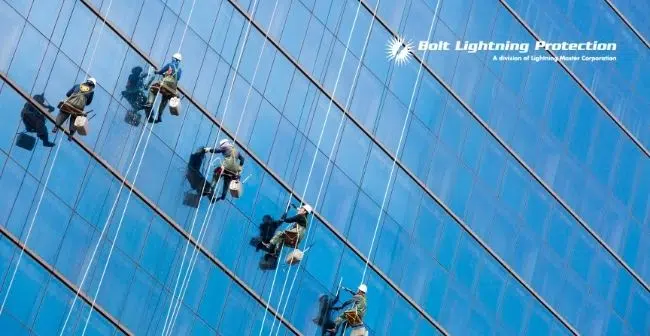Lightning Protection Code—Safeguard Your Employees and Assets from Risks Associated with Lightning
Lightning protection systems (LPS) for commercial and industrial facilities are not typically a requirement of national building codes. That said, losses due to lightning strikes and damage, whether direct or indirect, can run into the billions of dollars each year. The sheer power of a lightning strike can cause extensive property damage and completely disrupt a facility’s operations with costly downtime. Fortunately, most of these losses can be mitigated through the implementation of effective a lightning protection system.
Even though lightning protection is not required by code, there are several international and national standards that can be referenced that ensure the best possible quality in materials and installation practices. Let’s look at the lightning protection standards in place to help keep your facility safe and operations running smoothly.
The Basics of Lightning Protection Standards
The NFPA 780 Standard for the Installation of Lightning Protection Systems is published and reviewed on a three-year cycle by the National Fire Protection Association (NFPA). It establishes the basis of design and installation requirements for lightning protection systems. If you are installing a lightning protection system, then it is important to choose a company that can design a system according to NFPA 780, which should mitigate your risks associated potential lightning damage and reduce downtime.
Additionally, the IEC 62305 & IEC 62651 Standards for Protection Against Lightning inform the standards for lightning protection around the world. These standards are developed by the International Electrotechnical Commission (IEC) and serve as the basis for risk and quality management for lightning protection systems.
What’s more, these standards take stock of the growing impact of technology and communication systems in industrial and business activities and set forth appropriate measures.
Other crucial lightning protection standards include the Underwriters Laboratories UL 96A, which addresses the requirements for construction or installation of lightning protection system requirements.
It’s important to understand the codes and standards in place and it’s crucial to work with a contractor who’s not only familiar with these standards but has gone to the extent of gaining the appropriate certifications. Doing so provides the highest level of safety and quality available and ensures your lightning protection system follows proper design, installation, and maintenance practices.
When Is Lightning Protection Required?
The chance that your facility will be hit by lightning depends on a variety of factors, including location, structure height, design, and whether the building is isolated. For this reason, it may be of importance to have a lightning risk assessment done to determine the safety of personnel at the facility and the facility’s risk of being struck by lightning, and the potential damage to the structure in the event of a lightning strike.
Understanding your facility’s vulnerabilities is key to installing a lightning protection system. A lightning risk assessment is an intricate process that requires you to work with an expert. It requires an understanding of your facility’s structure via Google Earth and/or engineering drawings and might require a physical site visit if those sources don’t provide enough data.
At Lightning Master, we can conduct a risk assessment to:
- Evaluate the condition of existing lightning protection systems to determine whether upgrades or improvements are required.
- Determine the lightning flash density – the higher the density, the higher level of lightning protection your facility will need.
- Assessment of the risk of a lightning strike to people, buildings, and equipment.
- Study maintenance aspects of your lightning protection measures such as surge protection, shielding, and grounding electrodes to recommend applicable corrective measures.
Upon completion of the inspection, you’ll receive a full report with findings and recommendations for installing a lightning protection system that meets the applicable industry standards.
It is important to note that Lightning protection is risk mitigation, not insurance. No technology, service, or product can guarantee complete protection of persons or property from injury, death, or damage resulting from lightning, transient voltage surge or static discharge, and Lightning Master Corporation makes no such guarantee or warranty.
Based on these standards, there are three attributes that need to be factored in to ensure an effective lightning protection system is in place:
- Strike termination devices – include a network of air terminals (lightning rods), cable conductors, and grounding electrode systems to intercept direct lightning strikes before they reach insulated building materials.
- Bonding and grounding system – bonding involves bringing all electrical and metal bodies in a facility to the same electric potential, while grounding brings the bonded equipment to the potential of the surface of the earth, protecting personnel, the structure, and its contents.
- Surge protection devices – a transient voltage surge suppression system absorbs and distributes excess voltage, protecting your equipment from transient voltage and current surges induced by electromagnetic fields created during a lightning strike.
Learn More About Lightning Protection Codes and Standards from Lightning Master
Lightning-related damage and losses can be mitigated by installing professionally designed lightning protection equipment. Lightning Master is the best resource for lightning protection equipment and systems in the nation. Designs and structural lightning protection systems and components meet NFPA 780 and UL requirements. Lightning Master manufactures highest quality stainless steel, titanium and Hastelloy components all made in the USA, which are made to withstand corrosive environments in industrial settings. We wrote the book on lightning and static protection.
It is important to note that Lightning protection is risk mitigation, not insurance. No technology, service, or product can guarantee complete protection of persons or property from injury, death, or damage resulting from lightning, transient voltage surge or static discharge, and Lightning Master Corporation makes no such guarantee or warranty.
Though there is no specific requirement for lighting protection, we recommend implementing preventative measures to avoid costly downtime. Contact Lightning Master’s experts to schedule a risk assessment or site survey to prepare your facility.




